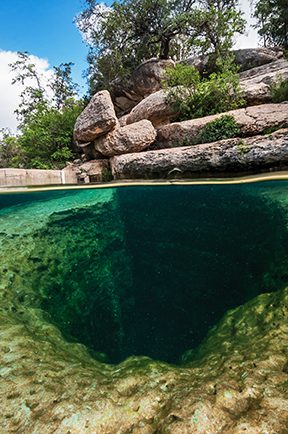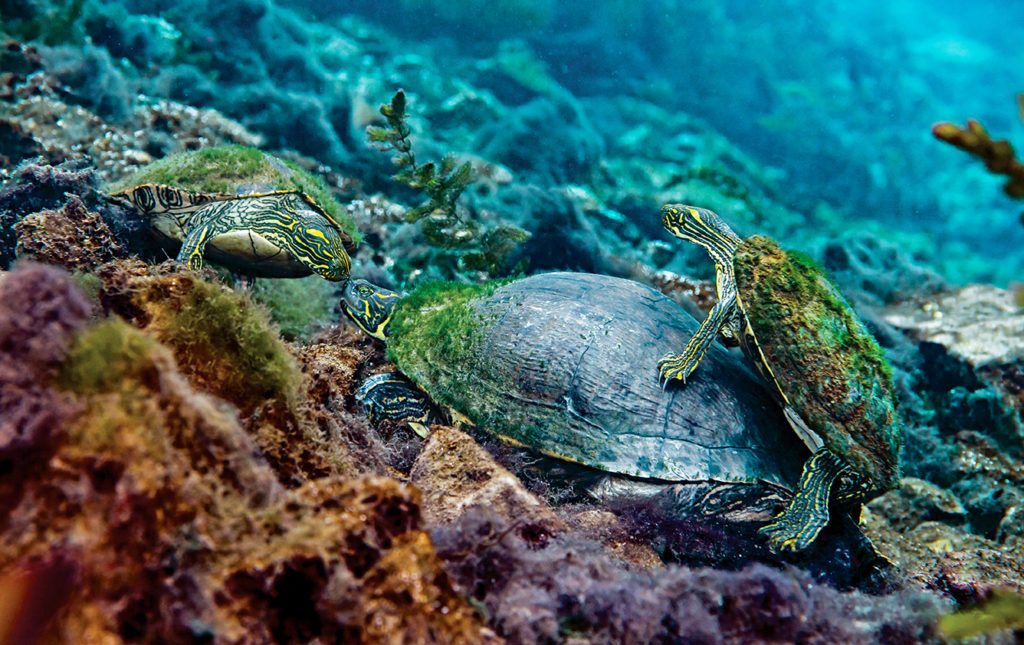I’M A NATIVE TEXAN, AND PEOPLE OFTEN ASK ME how an underwater photographer originates from Texas. They are sometimes unaware of the rich underwater resources our state offers. Our dive opportunities are diverse, from the Flower Garden Banks National Marine Sanctuary to reservoirs, rivers, and springs.
Freshwater aquifers run under most of the land and have a defining role in Texas’ geology. The unique springs of Central Texas have attracted inhabitants and explorers for at least 12,000 years. This feature has led to underwater exploration across the state, with some sites publicly accessible to divers.
Ecology
Aquifers, such as the unconfined Ogallala Aquifer, provide nearly 80 percent of Texas’ water for agricultural irrigation. Confined aquifers under positive pressure are called artesian aquifers and are known in West Texas through dive sites such as San Solomon Springs.
The Edwards Aquifer, a unique karst aquifer in Central Texas, created a system of springs for swimming, snorkeling, and diving. Comal Springs and San Marcos Springs are the largest springs in Texas. Access to abundant water flow from Barton Springs contributed to locating the state capital in Austin.
Precipitation can quickly recharge the Edwards Aquifer, but periods of drought or overuse from wells can easily empty it. Since the recharge zone for this aquifer covers a large area, it is also vulnerable to groundwater contamination. This contamination has contributed to several species being designated as threatened or endangered.
Seven endangered or threatened species live in Spring Lake. An eighth, the San Marcos gambusia, is presumed extinct from interbreeding. The Pecos gambusia is still in San Solomon Springs but is endangered. The species most interesting to divers — the fountain darter, San Marcos salamander, Texas blind salamander, and Texas wild-rice (an aquatic grass) — are all designated as endangered. Recent water changes are contributing to algal and bacterial growth throughout this habitat.


These mating yellow-bellied sliders are among the six species of turtle studied in Spring Lake.

A largemouth bass in Spring Lake opens its jaws wide.
Sites
You can access the springs through diving, snorkeling, or swimming, but some sites are not regularly open to public divers. Although shallow, all the springs feature constant water temperature, good visibility, and natural beauty throughout the year. In many places you can see the springs bubbling through the limestone. None of these dive sites employ dive flags due to limited boat traffic and shallow areas.
More than 200 springs flow through this 16-acre lake in San Marcos that looks more like a Florida spring than what you would expect in Texas. Although a small body of water, Spring Lake is the headwaters of the San Marcos River and is one of the most biologically diverse aquatic systems in the southwestern U.S. The U.S. Fish and Wildlife Department has designated it as a critical habitat.
The Meadows Center for Water and the Environment, a research and education organization dedicated to clean water, manages access to Spring Lake for dive professionals conducting training and for volunteers who help remove invasive plant species. To volunteer, you must complete the Dive Authorization Course and then register online for dive times. The dive coordinator arranges the volunteer dive sites.
In addition to threatened and endangered species, other common wildlife includes cabomba aquatic plants, spotted gar, snapping turtles, yellow-bellied sliders, bass, and Rio Grande cichlids. Big claw river prawn and crawfish lurk under rocks or in overhangs, and American eels occasionally emerge from vegetation at night.
The lake has named sites such as Arch Site, Riverbed, Cream of Wheat, and Deep Hole Spring, the deepest area in Spring Lake. A large pipe still covers the main spring just beyond the training area. Texas blind salamanders periodically exit the spring from this area, and scientists sometimes watch this spot to collect them.
San Marcos River
It can be hard to think of a river as a spring, but these Texas rivers that are spring-fed from the Edwards Aquifer are noticeably clearer than other area rivers, except following rains when runoff muddies the water.
The San Marcos River is a drift dive that begins at Sewell Park, just south of Burleson Dam, where you can enter from the sidewalk. The water is shallow enough in some places throughout the river to allow standing to slow your drift dive or pause for photographic opportunities.
The exit is at Rio Vista Park before you reach the dam. Depths increase downstream, and the river reaches its maximum depth of 10 feet under the bridges. Local swimmers and kayakers frequent the river, especially during summer. You should coordinate drop-off and pick-up locations to avoid long walks back to your vehicle.
Comal River
This popular drift dive goes from the top of Hinman Island Park in New Braunfels to Prince Solms Park, just 1,500 feet downriver. You can do this drift multiple times or continue your dive by riding the tube chute on the right side when it’s open. Fully inflate your buoyancy compensator, protect your face and equipment down the chute, and continue to the last tube exit, just past the Rockin’ R exit and before the Comal merges with the Guadalupe River.
The Schlitterbahn Waterpark in New Braunfels flanks the river, so parking is limited, and the city enforces towing. Arrive early, and send a diver back to retrieve the vehicle if you plan to drift dive down the river. Bring a collection bag for garbage left by tubers, and use it to avoid rocks during high-flow times if you plan to venture past the dam.
Barton Springs
This popular urban pool in Austin is open to swimming and snorkeling year-round with an admission fee. Although diving in Barton Springs is limited to occasionally being available as part of volunteer diving to clean the springs, snorkeling is welcome any time. Unlike Deep Eddy Pool, which is also spring-fed and is oldest swimming pool in Texas, Barton Springs retains its natural habitat.
The underwater environment here is like Spring Lake and has some of the same species. There are more large rocks on the bottom than at other sites, but the vegetation and spring areas are quite similar.

Trey Lessard emerges from under the restriction in Jacob’s Well.

Schooling largemouth bass follow divers in Spring Lake.
Jacob’s Well Natural Area
Jacob’s Well, an artesian spring in Wimberley, is the headwaters of Cypress Creek. It is closed to diving but open for visiting and swimming with a reservation through the Hays County Parks Department. Nearby Blue Hole Regional Park is a popular swimming area connected to the same spring.
The Jacob’s Well cave system features two main tunnels with a maximum depth of 140 feet. At least nine divers have died there, so it is now closed to all diving except for members of the Jacob’s Well Exploration Project, a group of trained and experienced cave divers who conduct exploration and research activities.
Despite its storied history, Jacob’s Well remains a popular park and swimming area. The cave environment connects to the Edwards Aquifer and is home to unique bacteria, amphipods, and San Marcos salamanders, especially in the front section. Water has carved smooth features throughout the limestone, sometimes creating sharp edges as it makes scalloped shapes during floods.
Changing Waters
Just like the waters carving limestone through the karst features of underwater caves and defining the springs and rivers of Central Texas, diving this region is a changing landscape. Publicly closed sites are unlikely to open to divers because of perceived liability risks and sometimes private property landowner preferences. The Edwards Aquifer runs through 11 counties in Texas and surfaces in many more locations than are on publicly accessible lands.
Although shallow, the appeal of these waters lies in their beauty. I’ve been diving in this region for more than two decades and look forward to every local exploration opportunity or visit to these well-known sites. These are easy recreational dives with long bottom times, and they provide dynamic subjects for photography and video.
How to Dive It
Getting there: Austin is central and features the Austin–Bergstrom International Airport. You will need a car to access all sites.
Conditions: All locations are shore dives available for year-round diving. Currents can sometimes be quite intense in the rivers following rains. Maximum depths reach 20 feet in Spring Lake with an average 10-foot depth for all locations except Jacob’s Well Natural Area. Be sure to make reservations well ahead of time to dive Spring Lake.
The water temperature in all springs is constant between 68°F and 72°F. Summer and spring break are exceptionally busy seasons, and winter is the least crowded.
Support: Several dive shops in Austin and one in San Marcos provide access to gas fills, gear, and training.
© Alert Diver — Q2 2022